An Analysis of the National Curriculum in India: Primary Education
VerifiedAdded on 2022/08/12
|16
|3677
|71
Essay
AI Summary
This essay provides a comprehensive analysis of the National Curriculum in India, specifically focusing on the primary education sector for learners aged 3-11. It begins by outlining the key features of the curriculum, including its aims, principles, and the documents that guide preschool and primary education. The essay emphasizes the importance of connecting knowledge to life outside of school, enriching the curriculum beyond textbooks, and fostering critical thinking. It then delves into the challenges within the Indian education system, particularly those related to teacher training, student engagement, and the language used in teaching practices. The essay highlights issues such as inadequate teacher training resources, low student engagement rates, and the difficulties faced by teachers in diverse classrooms. It also discusses the need for curriculum revisions and improvements to address these challenges and promote a more effective and inclusive educational environment. The essay concludes by summarizing the key features of the curriculum and the challenges identified, offering insights into the complexities of the Indian education system.
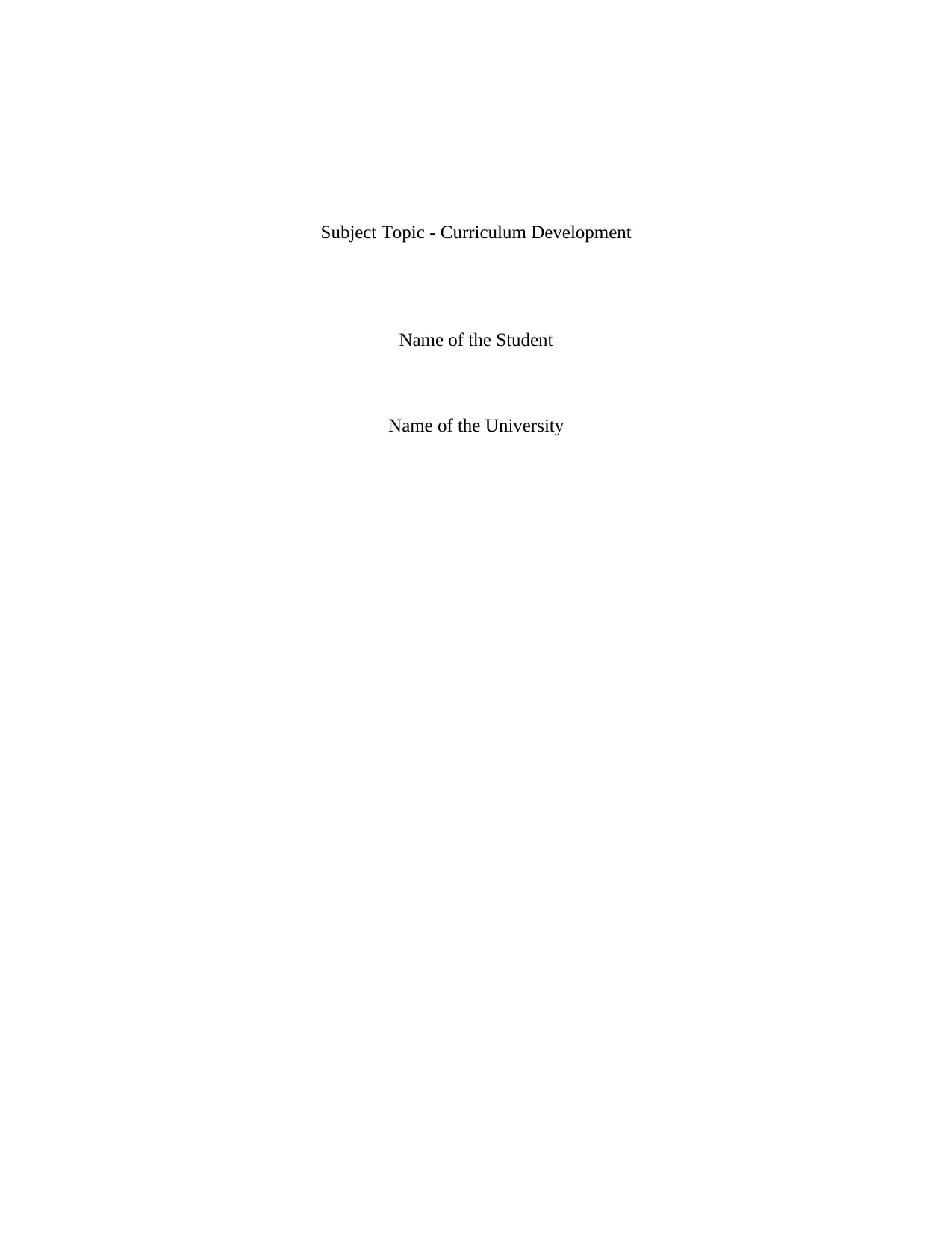
Subject Topic - Curriculum Development
Name of the Student
Name of the University
Name of the Student
Name of the University
Paraphrase This Document
Need a fresh take? Get an instant paraphrase of this document with our AI Paraphraser
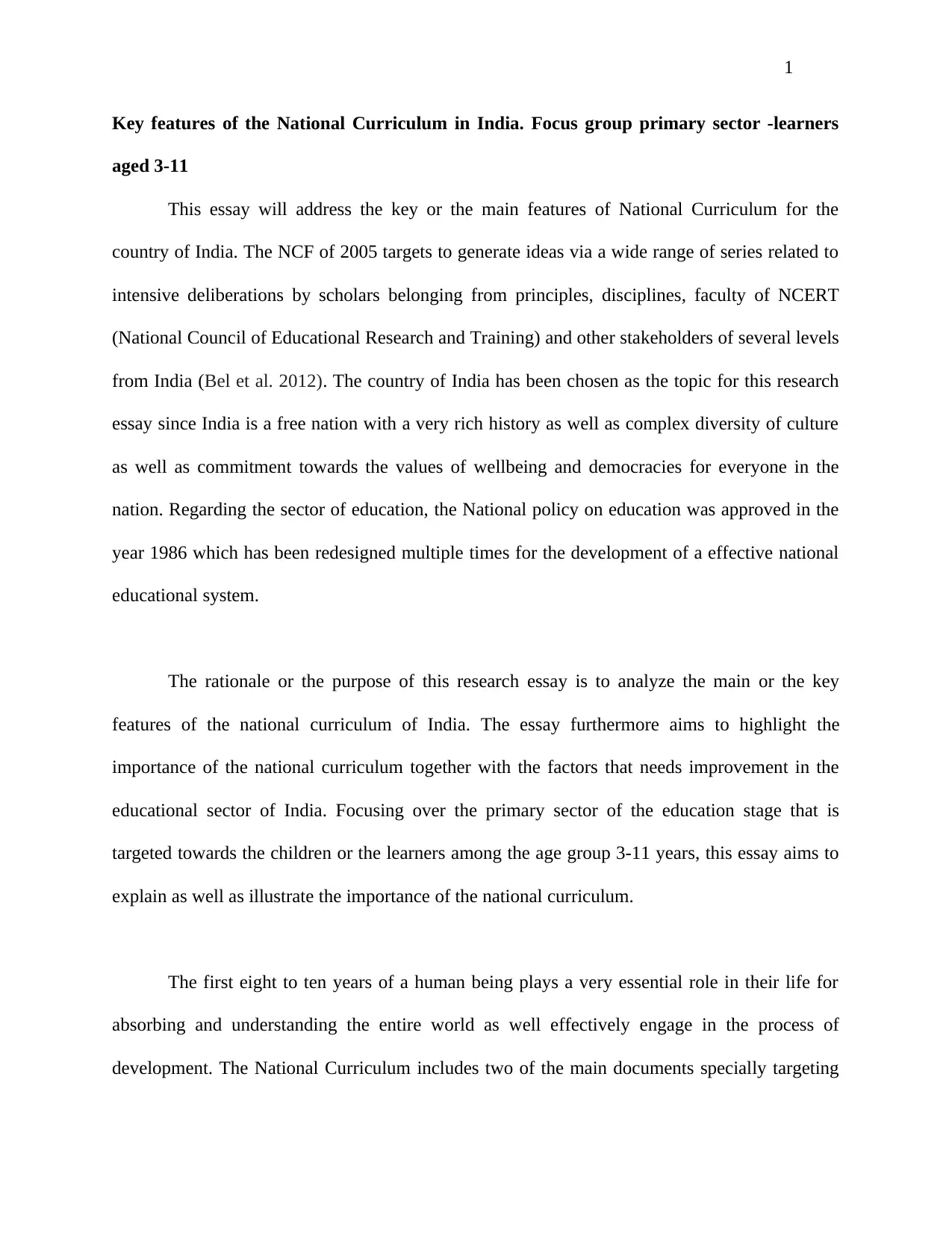
1
Key features of the National Curriculum in India. Focus group primary sector -learners
aged 3-11
This essay will address the key or the main features of National Curriculum for the
country of India. The NCF of 2005 targets to generate ideas via a wide range of series related to
intensive deliberations by scholars belonging from principles, disciplines, faculty of NCERT
(National Council of Educational Research and Training) and other stakeholders of several levels
from India (Bel et al. 2012). The country of India has been chosen as the topic for this research
essay since India is a free nation with a very rich history as well as complex diversity of culture
as well as commitment towards the values of wellbeing and democracies for everyone in the
nation. Regarding the sector of education, the National policy on education was approved in the
year 1986 which has been redesigned multiple times for the development of a effective national
educational system.
The rationale or the purpose of this research essay is to analyze the main or the key
features of the national curriculum of India. The essay furthermore aims to highlight the
importance of the national curriculum together with the factors that needs improvement in the
educational sector of India. Focusing over the primary sector of the education stage that is
targeted towards the children or the learners among the age group 3-11 years, this essay aims to
explain as well as illustrate the importance of the national curriculum.
The first eight to ten years of a human being plays a very essential role in their life for
absorbing and understanding the entire world as well effectively engage in the process of
development. The National Curriculum includes two of the main documents specially targeting
Key features of the National Curriculum in India. Focus group primary sector -learners
aged 3-11
This essay will address the key or the main features of National Curriculum for the
country of India. The NCF of 2005 targets to generate ideas via a wide range of series related to
intensive deliberations by scholars belonging from principles, disciplines, faculty of NCERT
(National Council of Educational Research and Training) and other stakeholders of several levels
from India (Bel et al. 2012). The country of India has been chosen as the topic for this research
essay since India is a free nation with a very rich history as well as complex diversity of culture
as well as commitment towards the values of wellbeing and democracies for everyone in the
nation. Regarding the sector of education, the National policy on education was approved in the
year 1986 which has been redesigned multiple times for the development of a effective national
educational system.
The rationale or the purpose of this research essay is to analyze the main or the key
features of the national curriculum of India. The essay furthermore aims to highlight the
importance of the national curriculum together with the factors that needs improvement in the
educational sector of India. Focusing over the primary sector of the education stage that is
targeted towards the children or the learners among the age group 3-11 years, this essay aims to
explain as well as illustrate the importance of the national curriculum.
The first eight to ten years of a human being plays a very essential role in their life for
absorbing and understanding the entire world as well effectively engage in the process of
development. The National Curriculum includes two of the main documents specially targeting
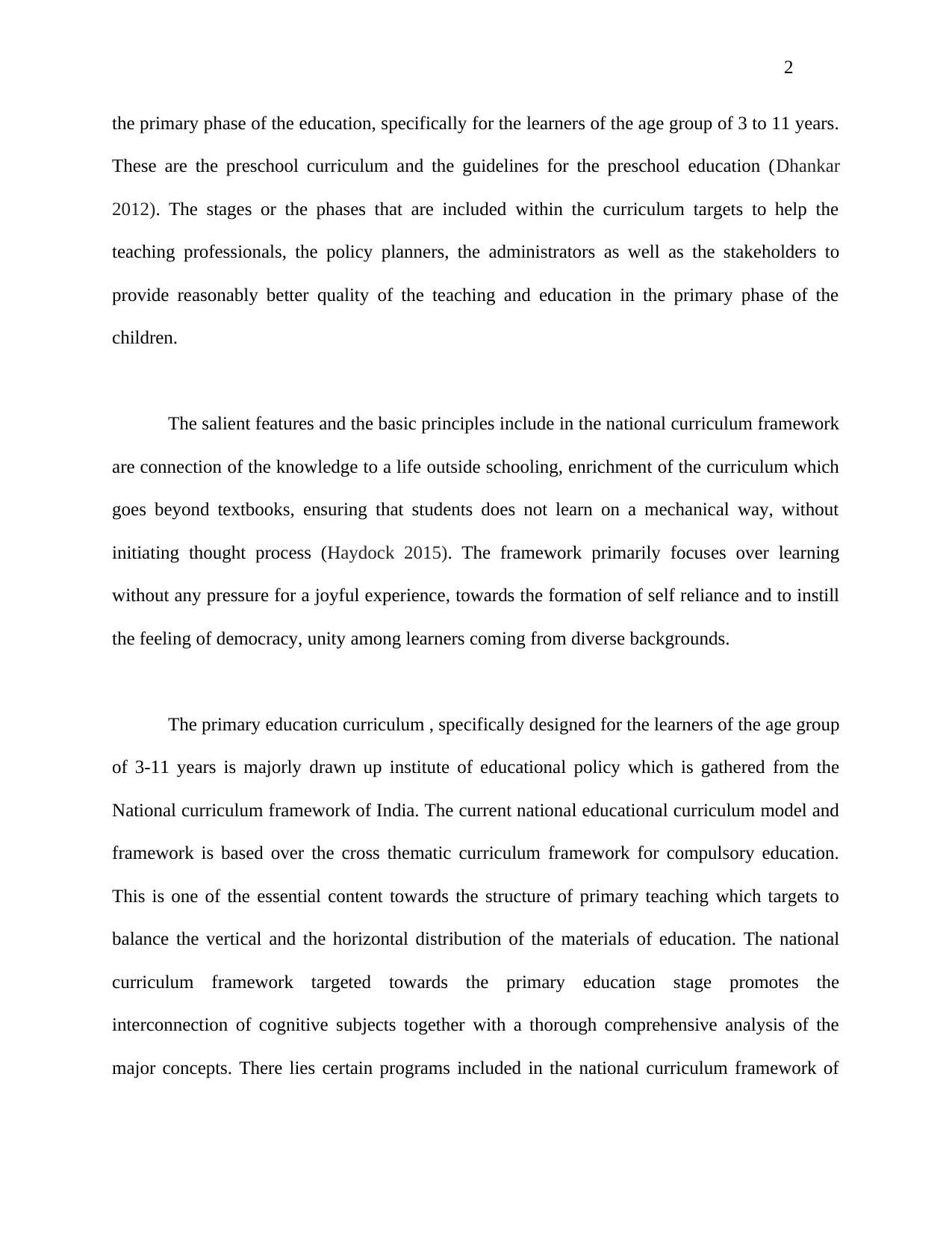
2
the primary phase of the education, specifically for the learners of the age group of 3 to 11 years.
These are the preschool curriculum and the guidelines for the preschool education (Dhankar
2012). The stages or the phases that are included within the curriculum targets to help the
teaching professionals, the policy planners, the administrators as well as the stakeholders to
provide reasonably better quality of the teaching and education in the primary phase of the
children.
The salient features and the basic principles include in the national curriculum framework
are connection of the knowledge to a life outside schooling, enrichment of the curriculum which
goes beyond textbooks, ensuring that students does not learn on a mechanical way, without
initiating thought process (Haydock 2015). The framework primarily focuses over learning
without any pressure for a joyful experience, towards the formation of self reliance and to instill
the feeling of democracy, unity among learners coming from diverse backgrounds.
The primary education curriculum , specifically designed for the learners of the age group
of 3-11 years is majorly drawn up institute of educational policy which is gathered from the
National curriculum framework of India. The current national educational curriculum model and
framework is based over the cross thematic curriculum framework for compulsory education.
This is one of the essential content towards the structure of primary teaching which targets to
balance the vertical and the horizontal distribution of the materials of education. The national
curriculum framework targeted towards the primary education stage promotes the
interconnection of cognitive subjects together with a thorough comprehensive analysis of the
major concepts. There lies certain programs included in the national curriculum framework of
the primary phase of the education, specifically for the learners of the age group of 3 to 11 years.
These are the preschool curriculum and the guidelines for the preschool education (Dhankar
2012). The stages or the phases that are included within the curriculum targets to help the
teaching professionals, the policy planners, the administrators as well as the stakeholders to
provide reasonably better quality of the teaching and education in the primary phase of the
children.
The salient features and the basic principles include in the national curriculum framework
are connection of the knowledge to a life outside schooling, enrichment of the curriculum which
goes beyond textbooks, ensuring that students does not learn on a mechanical way, without
initiating thought process (Haydock 2015). The framework primarily focuses over learning
without any pressure for a joyful experience, towards the formation of self reliance and to instill
the feeling of democracy, unity among learners coming from diverse backgrounds.
The primary education curriculum , specifically designed for the learners of the age group
of 3-11 years is majorly drawn up institute of educational policy which is gathered from the
National curriculum framework of India. The current national educational curriculum model and
framework is based over the cross thematic curriculum framework for compulsory education.
This is one of the essential content towards the structure of primary teaching which targets to
balance the vertical and the horizontal distribution of the materials of education. The national
curriculum framework targeted towards the primary education stage promotes the
interconnection of cognitive subjects together with a thorough comprehensive analysis of the
major concepts. There lies certain programs included in the national curriculum framework of
⊘ This is a preview!⊘
Do you want full access?
Subscribe today to unlock all pages.

Trusted by 1+ million students worldwide
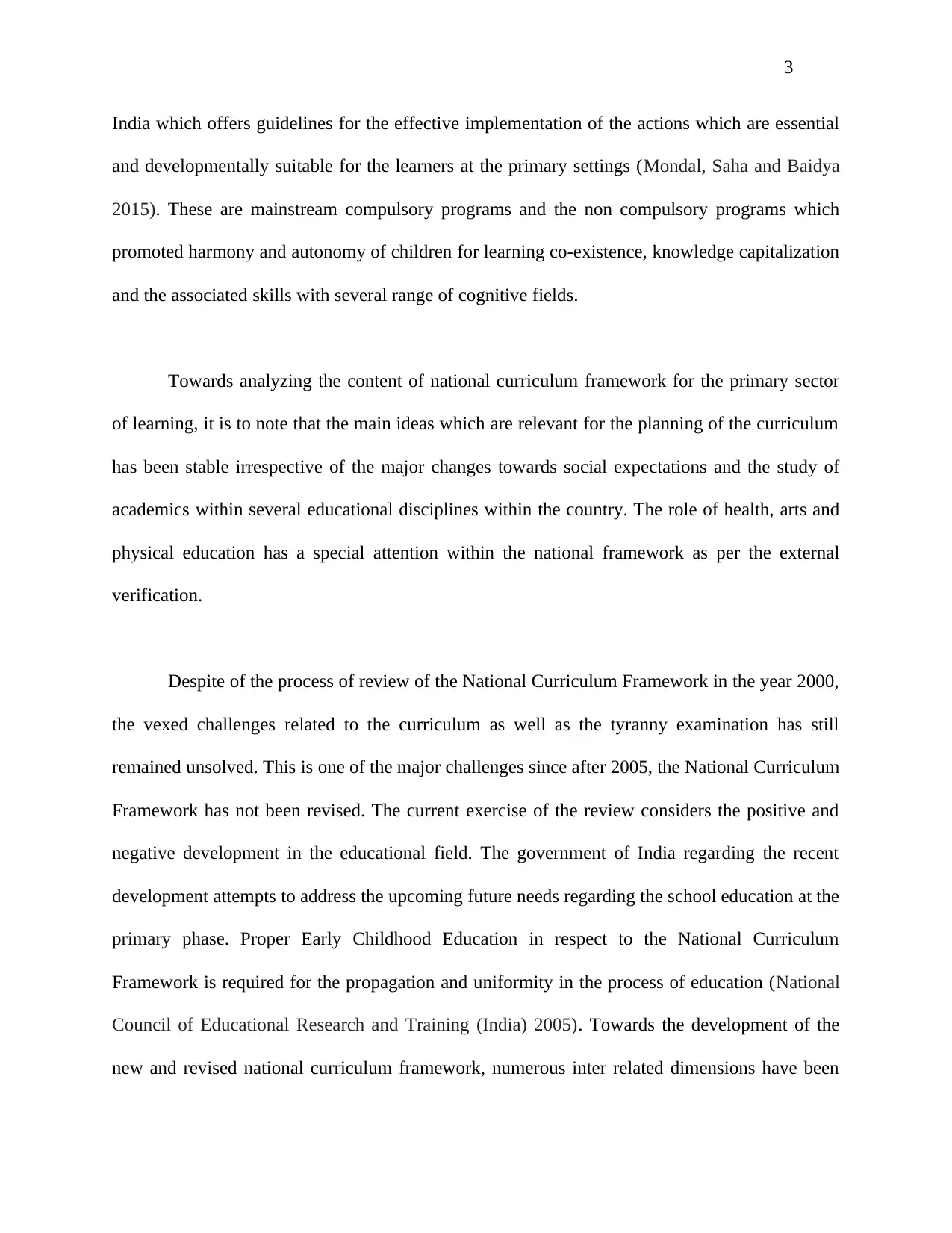
3
India which offers guidelines for the effective implementation of the actions which are essential
and developmentally suitable for the learners at the primary settings (Mondal, Saha and Baidya
2015). These are mainstream compulsory programs and the non compulsory programs which
promoted harmony and autonomy of children for learning co-existence, knowledge capitalization
and the associated skills with several range of cognitive fields.
Towards analyzing the content of national curriculum framework for the primary sector
of learning, it is to note that the main ideas which are relevant for the planning of the curriculum
has been stable irrespective of the major changes towards social expectations and the study of
academics within several educational disciplines within the country. The role of health, arts and
physical education has a special attention within the national framework as per the external
verification.
Despite of the process of review of the National Curriculum Framework in the year 2000,
the vexed challenges related to the curriculum as well as the tyranny examination has still
remained unsolved. This is one of the major challenges since after 2005, the National Curriculum
Framework has not been revised. The current exercise of the review considers the positive and
negative development in the educational field. The government of India regarding the recent
development attempts to address the upcoming future needs regarding the school education at the
primary phase. Proper Early Childhood Education in respect to the National Curriculum
Framework is required for the propagation and uniformity in the process of education (National
Council of Educational Research and Training (India) 2005). Towards the development of the
new and revised national curriculum framework, numerous inter related dimensions have been
India which offers guidelines for the effective implementation of the actions which are essential
and developmentally suitable for the learners at the primary settings (Mondal, Saha and Baidya
2015). These are mainstream compulsory programs and the non compulsory programs which
promoted harmony and autonomy of children for learning co-existence, knowledge capitalization
and the associated skills with several range of cognitive fields.
Towards analyzing the content of national curriculum framework for the primary sector
of learning, it is to note that the main ideas which are relevant for the planning of the curriculum
has been stable irrespective of the major changes towards social expectations and the study of
academics within several educational disciplines within the country. The role of health, arts and
physical education has a special attention within the national framework as per the external
verification.
Despite of the process of review of the National Curriculum Framework in the year 2000,
the vexed challenges related to the curriculum as well as the tyranny examination has still
remained unsolved. This is one of the major challenges since after 2005, the National Curriculum
Framework has not been revised. The current exercise of the review considers the positive and
negative development in the educational field. The government of India regarding the recent
development attempts to address the upcoming future needs regarding the school education at the
primary phase. Proper Early Childhood Education in respect to the National Curriculum
Framework is required for the propagation and uniformity in the process of education (National
Council of Educational Research and Training (India) 2005). Towards the development of the
new and revised national curriculum framework, numerous inter related dimensions have been
Paraphrase This Document
Need a fresh take? Get an instant paraphrase of this document with our AI Paraphraser
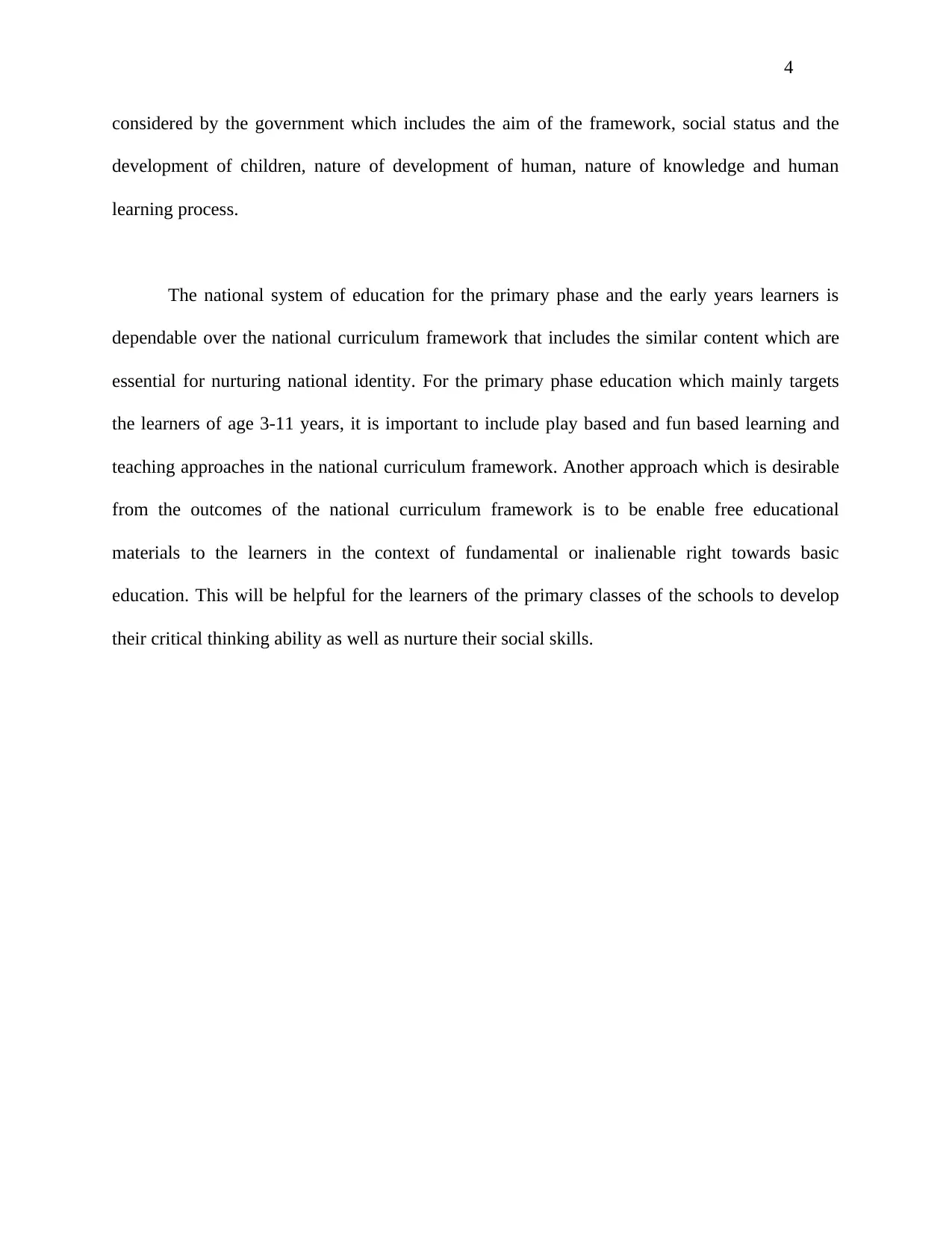
4
considered by the government which includes the aim of the framework, social status and the
development of children, nature of development of human, nature of knowledge and human
learning process.
The national system of education for the primary phase and the early years learners is
dependable over the national curriculum framework that includes the similar content which are
essential for nurturing national identity. For the primary phase education which mainly targets
the learners of age 3-11 years, it is important to include play based and fun based learning and
teaching approaches in the national curriculum framework. Another approach which is desirable
from the outcomes of the national curriculum framework is to be enable free educational
materials to the learners in the context of fundamental or inalienable right towards basic
education. This will be helpful for the learners of the primary classes of the schools to develop
their critical thinking ability as well as nurture their social skills.
considered by the government which includes the aim of the framework, social status and the
development of children, nature of development of human, nature of knowledge and human
learning process.
The national system of education for the primary phase and the early years learners is
dependable over the national curriculum framework that includes the similar content which are
essential for nurturing national identity. For the primary phase education which mainly targets
the learners of age 3-11 years, it is important to include play based and fun based learning and
teaching approaches in the national curriculum framework. Another approach which is desirable
from the outcomes of the national curriculum framework is to be enable free educational
materials to the learners in the context of fundamental or inalienable right towards basic
education. This will be helpful for the learners of the primary classes of the schools to develop
their critical thinking ability as well as nurture their social skills.
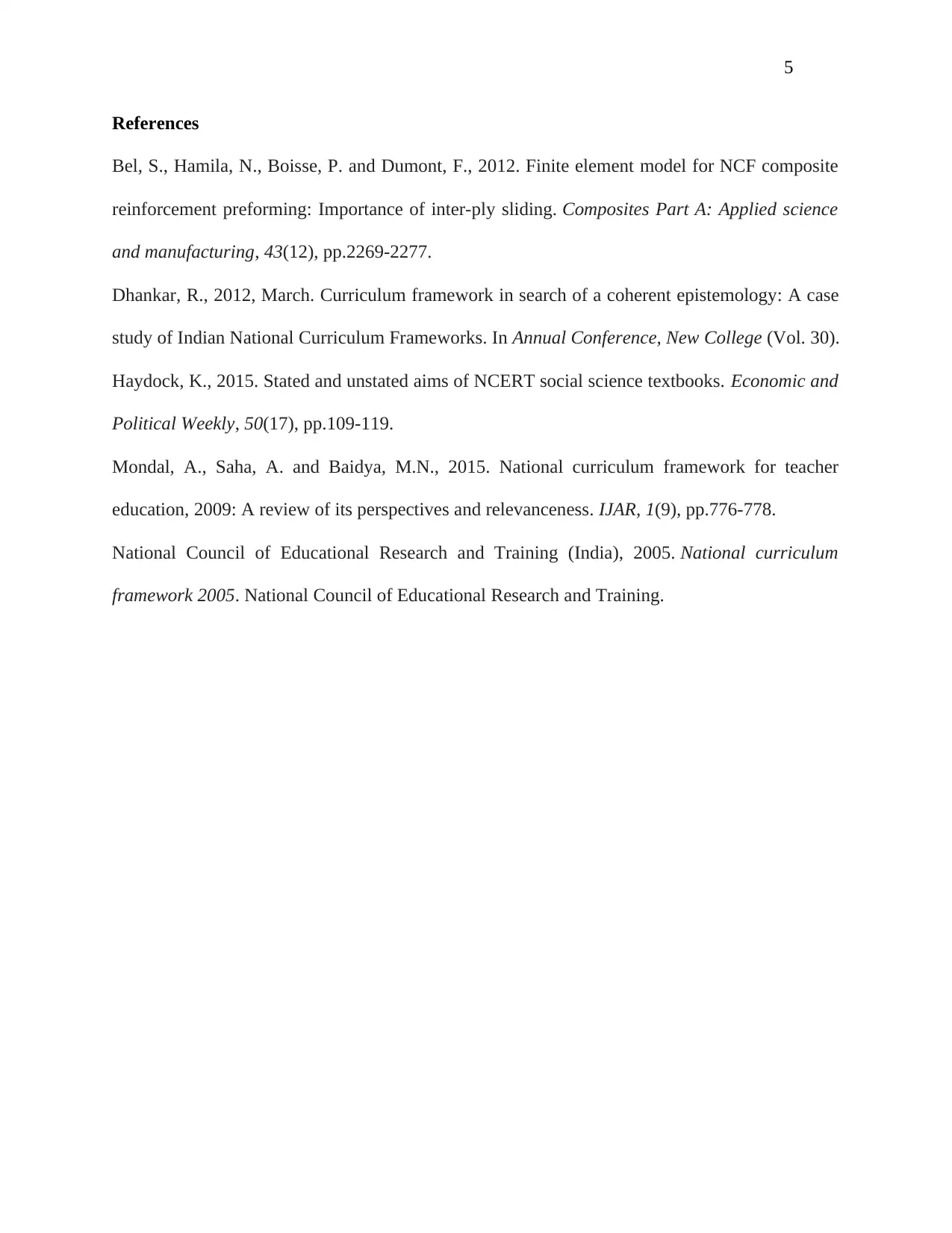
5
References
Bel, S., Hamila, N., Boisse, P. and Dumont, F., 2012. Finite element model for NCF composite
reinforcement preforming: Importance of inter-ply sliding. Composites Part A: Applied science
and manufacturing, 43(12), pp.2269-2277.
Dhankar, R., 2012, March. Curriculum framework in search of a coherent epistemology: A case
study of Indian National Curriculum Frameworks. In Annual Conference, New College (Vol. 30).
Haydock, K., 2015. Stated and unstated aims of NCERT social science textbooks. Economic and
Political Weekly, 50(17), pp.109-119.
Mondal, A., Saha, A. and Baidya, M.N., 2015. National curriculum framework for teacher
education, 2009: A review of its perspectives and relevanceness. IJAR, 1(9), pp.776-778.
National Council of Educational Research and Training (India), 2005. National curriculum
framework 2005. National Council of Educational Research and Training.
References
Bel, S., Hamila, N., Boisse, P. and Dumont, F., 2012. Finite element model for NCF composite
reinforcement preforming: Importance of inter-ply sliding. Composites Part A: Applied science
and manufacturing, 43(12), pp.2269-2277.
Dhankar, R., 2012, March. Curriculum framework in search of a coherent epistemology: A case
study of Indian National Curriculum Frameworks. In Annual Conference, New College (Vol. 30).
Haydock, K., 2015. Stated and unstated aims of NCERT social science textbooks. Economic and
Political Weekly, 50(17), pp.109-119.
Mondal, A., Saha, A. and Baidya, M.N., 2015. National curriculum framework for teacher
education, 2009: A review of its perspectives and relevanceness. IJAR, 1(9), pp.776-778.
National Council of Educational Research and Training (India), 2005. National curriculum
framework 2005. National Council of Educational Research and Training.
⊘ This is a preview!⊘
Do you want full access?
Subscribe today to unlock all pages.

Trusted by 1+ million students worldwide
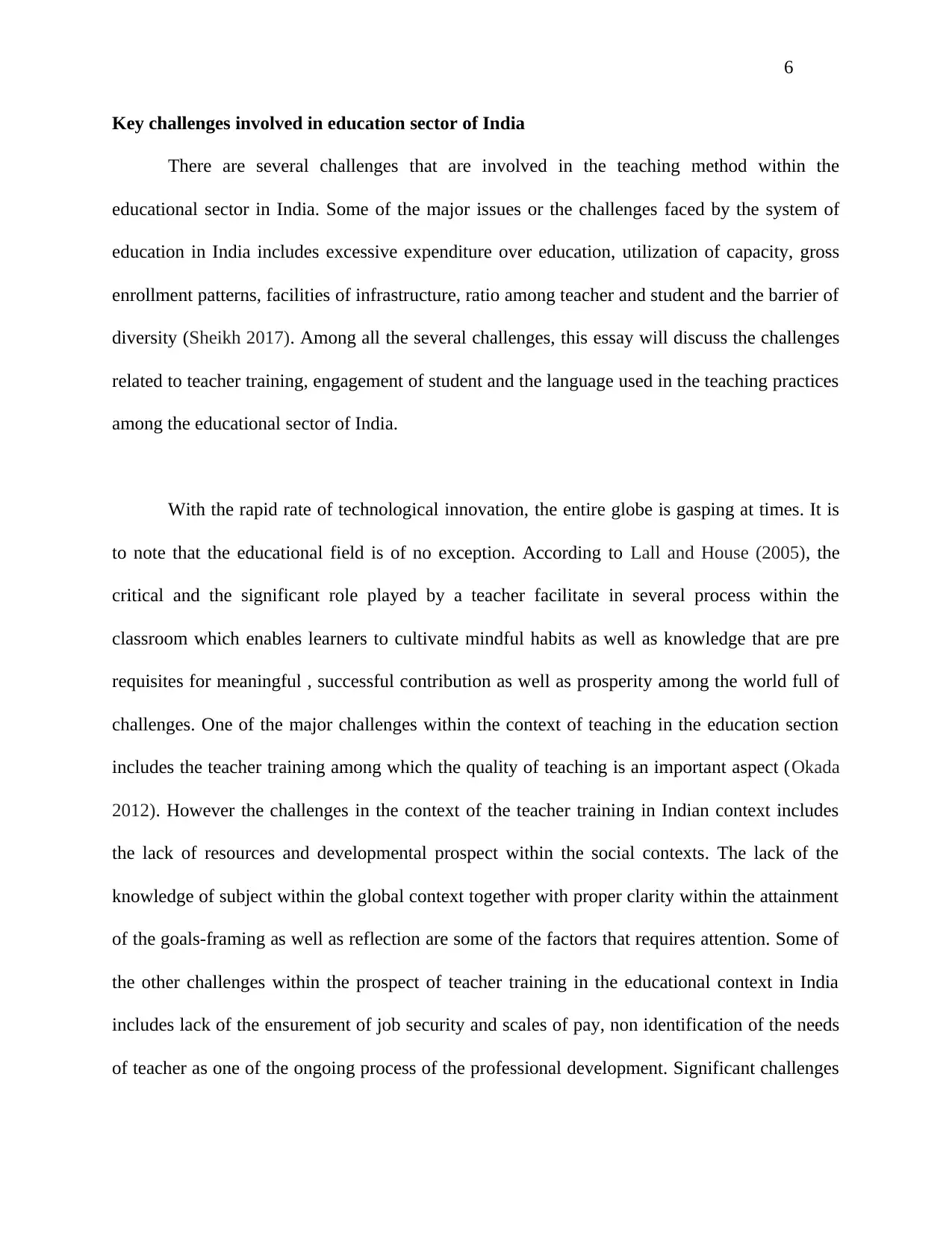
6
Key challenges involved in education sector of India
There are several challenges that are involved in the teaching method within the
educational sector in India. Some of the major issues or the challenges faced by the system of
education in India includes excessive expenditure over education, utilization of capacity, gross
enrollment patterns, facilities of infrastructure, ratio among teacher and student and the barrier of
diversity (Sheikh 2017). Among all the several challenges, this essay will discuss the challenges
related to teacher training, engagement of student and the language used in the teaching practices
among the educational sector of India.
With the rapid rate of technological innovation, the entire globe is gasping at times. It is
to note that the educational field is of no exception. According to Lall and House (2005), the
critical and the significant role played by a teacher facilitate in several process within the
classroom which enables learners to cultivate mindful habits as well as knowledge that are pre
requisites for meaningful , successful contribution as well as prosperity among the world full of
challenges. One of the major challenges within the context of teaching in the education section
includes the teacher training among which the quality of teaching is an important aspect (Okada
2012). However the challenges in the context of the teacher training in Indian context includes
the lack of resources and developmental prospect within the social contexts. The lack of the
knowledge of subject within the global context together with proper clarity within the attainment
of the goals-framing as well as reflection are some of the factors that requires attention. Some of
the other challenges within the prospect of teacher training in the educational context in India
includes lack of the ensurement of job security and scales of pay, non identification of the needs
of teacher as one of the ongoing process of the professional development. Significant challenges
Key challenges involved in education sector of India
There are several challenges that are involved in the teaching method within the
educational sector in India. Some of the major issues or the challenges faced by the system of
education in India includes excessive expenditure over education, utilization of capacity, gross
enrollment patterns, facilities of infrastructure, ratio among teacher and student and the barrier of
diversity (Sheikh 2017). Among all the several challenges, this essay will discuss the challenges
related to teacher training, engagement of student and the language used in the teaching practices
among the educational sector of India.
With the rapid rate of technological innovation, the entire globe is gasping at times. It is
to note that the educational field is of no exception. According to Lall and House (2005), the
critical and the significant role played by a teacher facilitate in several process within the
classroom which enables learners to cultivate mindful habits as well as knowledge that are pre
requisites for meaningful , successful contribution as well as prosperity among the world full of
challenges. One of the major challenges within the context of teaching in the education section
includes the teacher training among which the quality of teaching is an important aspect (Okada
2012). However the challenges in the context of the teacher training in Indian context includes
the lack of resources and developmental prospect within the social contexts. The lack of the
knowledge of subject within the global context together with proper clarity within the attainment
of the goals-framing as well as reflection are some of the factors that requires attention. Some of
the other challenges within the prospect of teacher training in the educational context in India
includes lack of the ensurement of job security and scales of pay, non identification of the needs
of teacher as one of the ongoing process of the professional development. Significant challenges
Paraphrase This Document
Need a fresh take? Get an instant paraphrase of this document with our AI Paraphraser
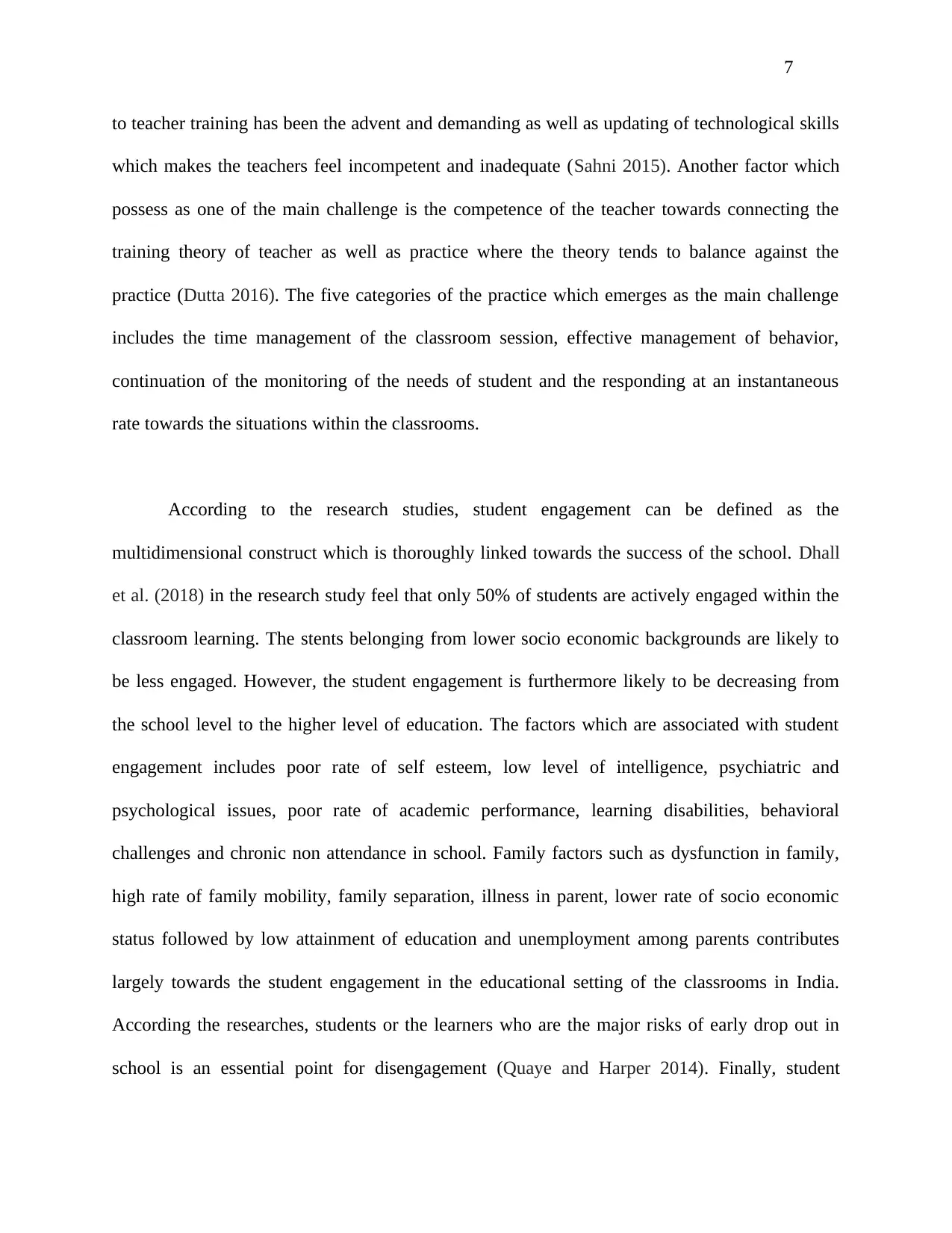
7
to teacher training has been the advent and demanding as well as updating of technological skills
which makes the teachers feel incompetent and inadequate (Sahni 2015). Another factor which
possess as one of the main challenge is the competence of the teacher towards connecting the
training theory of teacher as well as practice where the theory tends to balance against the
practice (Dutta 2016). The five categories of the practice which emerges as the main challenge
includes the time management of the classroom session, effective management of behavior,
continuation of the monitoring of the needs of student and the responding at an instantaneous
rate towards the situations within the classrooms.
According to the research studies, student engagement can be defined as the
multidimensional construct which is thoroughly linked towards the success of the school. Dhall
et al. (2018) in the research study feel that only 50% of students are actively engaged within the
classroom learning. The stents belonging from lower socio economic backgrounds are likely to
be less engaged. However, the student engagement is furthermore likely to be decreasing from
the school level to the higher level of education. The factors which are associated with student
engagement includes poor rate of self esteem, low level of intelligence, psychiatric and
psychological issues, poor rate of academic performance, learning disabilities, behavioral
challenges and chronic non attendance in school. Family factors such as dysfunction in family,
high rate of family mobility, family separation, illness in parent, lower rate of socio economic
status followed by low attainment of education and unemployment among parents contributes
largely towards the student engagement in the educational setting of the classrooms in India.
According the researches, students or the learners who are the major risks of early drop out in
school is an essential point for disengagement (Quaye and Harper 2014). Finally, student
to teacher training has been the advent and demanding as well as updating of technological skills
which makes the teachers feel incompetent and inadequate (Sahni 2015). Another factor which
possess as one of the main challenge is the competence of the teacher towards connecting the
training theory of teacher as well as practice where the theory tends to balance against the
practice (Dutta 2016). The five categories of the practice which emerges as the main challenge
includes the time management of the classroom session, effective management of behavior,
continuation of the monitoring of the needs of student and the responding at an instantaneous
rate towards the situations within the classrooms.
According to the research studies, student engagement can be defined as the
multidimensional construct which is thoroughly linked towards the success of the school. Dhall
et al. (2018) in the research study feel that only 50% of students are actively engaged within the
classroom learning. The stents belonging from lower socio economic backgrounds are likely to
be less engaged. However, the student engagement is furthermore likely to be decreasing from
the school level to the higher level of education. The factors which are associated with student
engagement includes poor rate of self esteem, low level of intelligence, psychiatric and
psychological issues, poor rate of academic performance, learning disabilities, behavioral
challenges and chronic non attendance in school. Family factors such as dysfunction in family,
high rate of family mobility, family separation, illness in parent, lower rate of socio economic
status followed by low attainment of education and unemployment among parents contributes
largely towards the student engagement in the educational setting of the classrooms in India.
According the researches, students or the learners who are the major risks of early drop out in
school is an essential point for disengagement (Quaye and Harper 2014). Finally, student
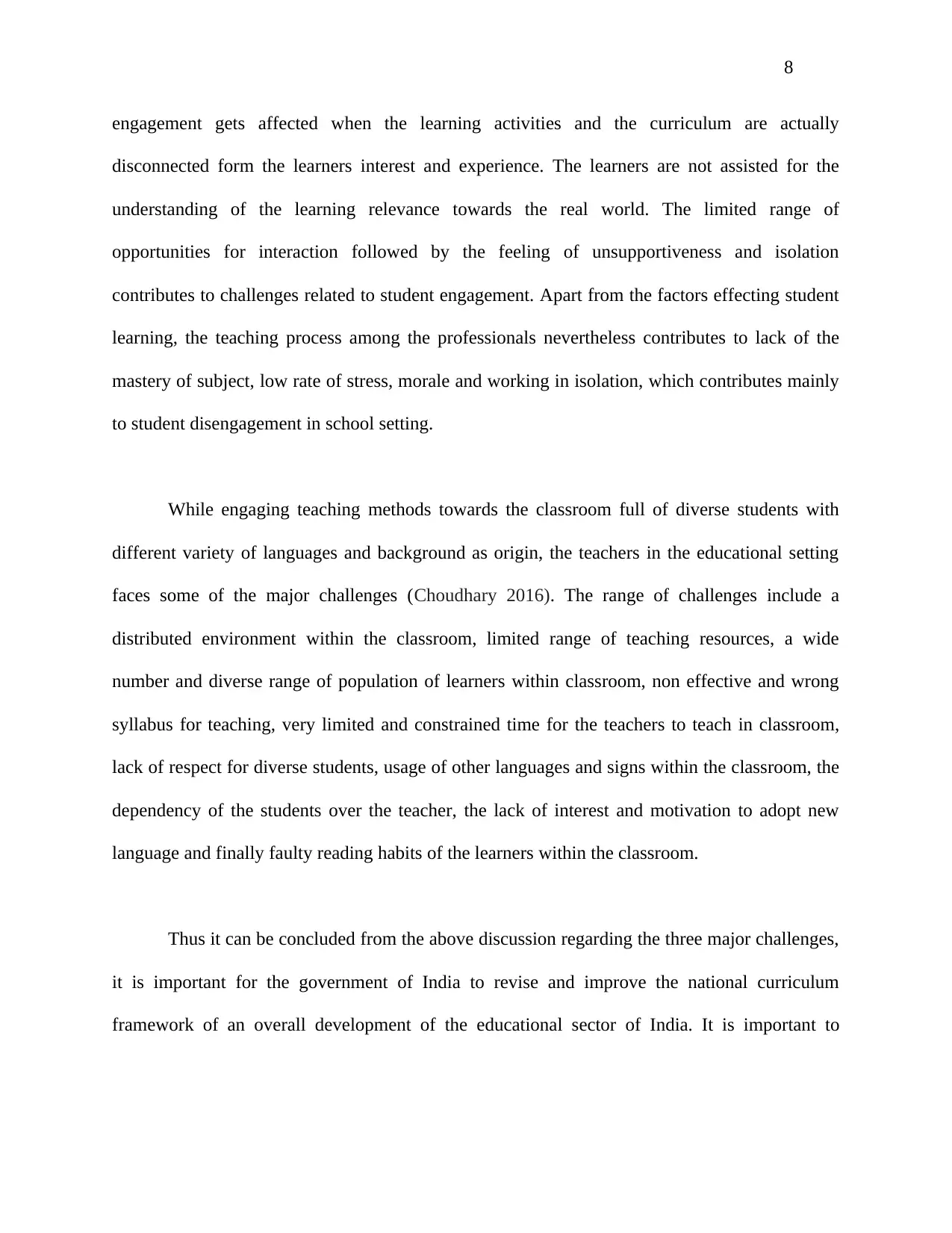
8
engagement gets affected when the learning activities and the curriculum are actually
disconnected form the learners interest and experience. The learners are not assisted for the
understanding of the learning relevance towards the real world. The limited range of
opportunities for interaction followed by the feeling of unsupportiveness and isolation
contributes to challenges related to student engagement. Apart from the factors effecting student
learning, the teaching process among the professionals nevertheless contributes to lack of the
mastery of subject, low rate of stress, morale and working in isolation, which contributes mainly
to student disengagement in school setting.
While engaging teaching methods towards the classroom full of diverse students with
different variety of languages and background as origin, the teachers in the educational setting
faces some of the major challenges (Choudhary 2016). The range of challenges include a
distributed environment within the classroom, limited range of teaching resources, a wide
number and diverse range of population of learners within classroom, non effective and wrong
syllabus for teaching, very limited and constrained time for the teachers to teach in classroom,
lack of respect for diverse students, usage of other languages and signs within the classroom, the
dependency of the students over the teacher, the lack of interest and motivation to adopt new
language and finally faulty reading habits of the learners within the classroom.
Thus it can be concluded from the above discussion regarding the three major challenges,
it is important for the government of India to revise and improve the national curriculum
framework of an overall development of the educational sector of India. It is important to
engagement gets affected when the learning activities and the curriculum are actually
disconnected form the learners interest and experience. The learners are not assisted for the
understanding of the learning relevance towards the real world. The limited range of
opportunities for interaction followed by the feeling of unsupportiveness and isolation
contributes to challenges related to student engagement. Apart from the factors effecting student
learning, the teaching process among the professionals nevertheless contributes to lack of the
mastery of subject, low rate of stress, morale and working in isolation, which contributes mainly
to student disengagement in school setting.
While engaging teaching methods towards the classroom full of diverse students with
different variety of languages and background as origin, the teachers in the educational setting
faces some of the major challenges (Choudhary 2016). The range of challenges include a
distributed environment within the classroom, limited range of teaching resources, a wide
number and diverse range of population of learners within classroom, non effective and wrong
syllabus for teaching, very limited and constrained time for the teachers to teach in classroom,
lack of respect for diverse students, usage of other languages and signs within the classroom, the
dependency of the students over the teacher, the lack of interest and motivation to adopt new
language and finally faulty reading habits of the learners within the classroom.
Thus it can be concluded from the above discussion regarding the three major challenges,
it is important for the government of India to revise and improve the national curriculum
framework of an overall development of the educational sector of India. It is important to
⊘ This is a preview!⊘
Do you want full access?
Subscribe today to unlock all pages.

Trusted by 1+ million students worldwide
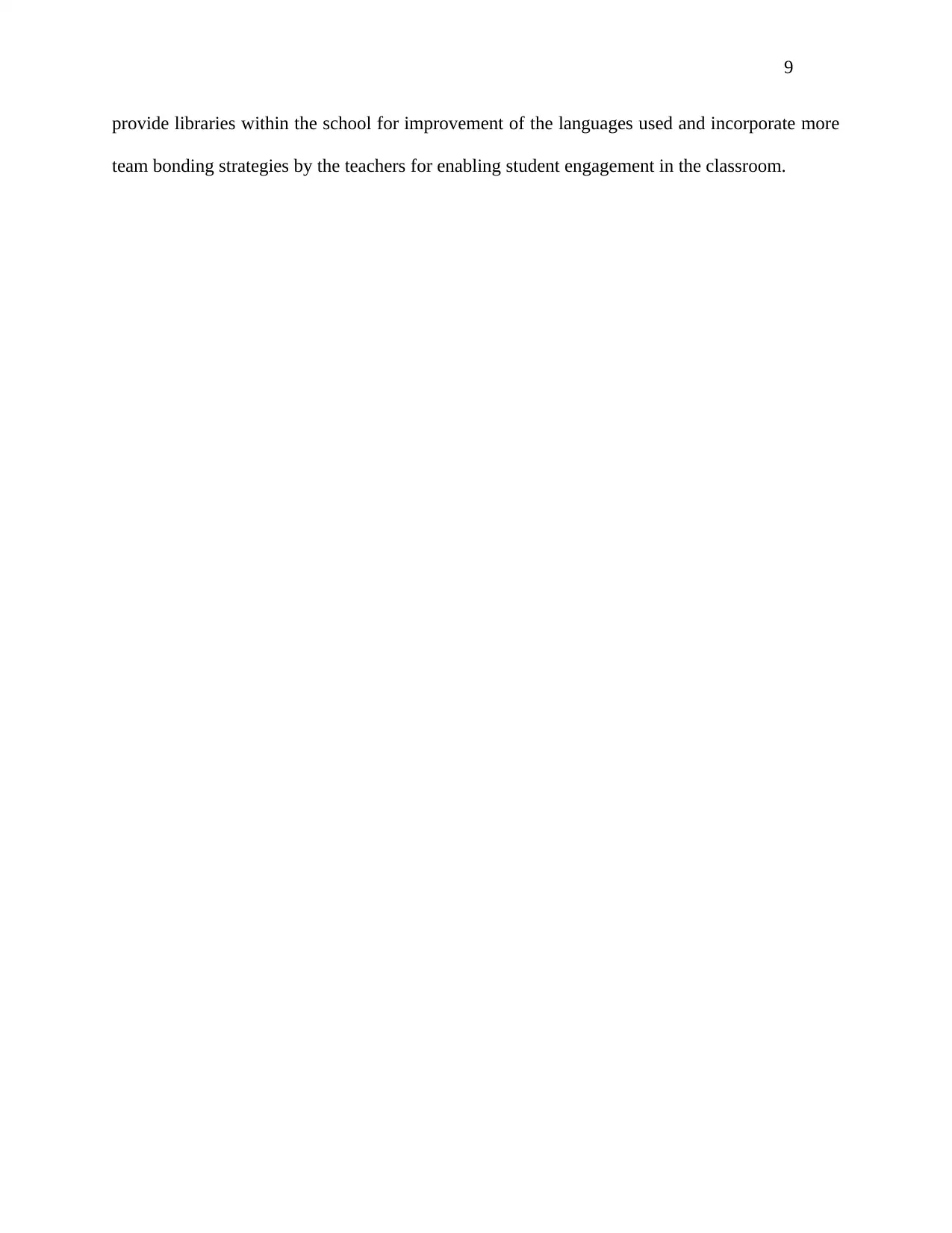
9
provide libraries within the school for improvement of the languages used and incorporate more
team bonding strategies by the teachers for enabling student engagement in the classroom.
provide libraries within the school for improvement of the languages used and incorporate more
team bonding strategies by the teachers for enabling student engagement in the classroom.
Paraphrase This Document
Need a fresh take? Get an instant paraphrase of this document with our AI Paraphraser
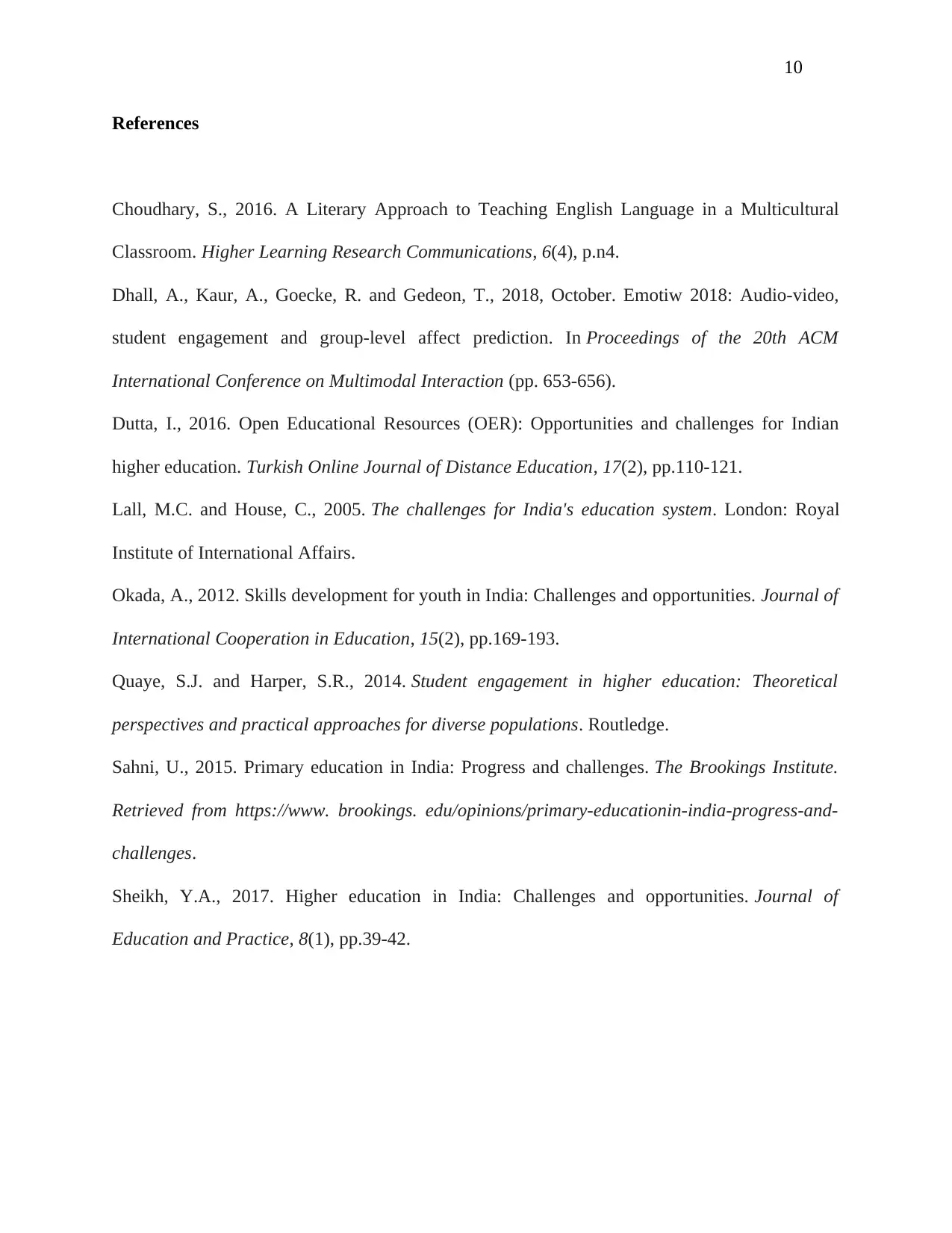
10
References
Choudhary, S., 2016. A Literary Approach to Teaching English Language in a Multicultural
Classroom. Higher Learning Research Communications, 6(4), p.n4.
Dhall, A., Kaur, A., Goecke, R. and Gedeon, T., 2018, October. Emotiw 2018: Audio-video,
student engagement and group-level affect prediction. In Proceedings of the 20th ACM
International Conference on Multimodal Interaction (pp. 653-656).
Dutta, I., 2016. Open Educational Resources (OER): Opportunities and challenges for Indian
higher education. Turkish Online Journal of Distance Education, 17(2), pp.110-121.
Lall, M.C. and House, C., 2005. The challenges for India's education system. London: Royal
Institute of International Affairs.
Okada, A., 2012. Skills development for youth in India: Challenges and opportunities. Journal of
International Cooperation in Education, 15(2), pp.169-193.
Quaye, S.J. and Harper, S.R., 2014. Student engagement in higher education: Theoretical
perspectives and practical approaches for diverse populations. Routledge.
Sahni, U., 2015. Primary education in India: Progress and challenges. The Brookings Institute.
Retrieved from https://www. brookings. edu/opinions/primary-educationin-india-progress-and-
challenges.
Sheikh, Y.A., 2017. Higher education in India: Challenges and opportunities. Journal of
Education and Practice, 8(1), pp.39-42.
References
Choudhary, S., 2016. A Literary Approach to Teaching English Language in a Multicultural
Classroom. Higher Learning Research Communications, 6(4), p.n4.
Dhall, A., Kaur, A., Goecke, R. and Gedeon, T., 2018, October. Emotiw 2018: Audio-video,
student engagement and group-level affect prediction. In Proceedings of the 20th ACM
International Conference on Multimodal Interaction (pp. 653-656).
Dutta, I., 2016. Open Educational Resources (OER): Opportunities and challenges for Indian
higher education. Turkish Online Journal of Distance Education, 17(2), pp.110-121.
Lall, M.C. and House, C., 2005. The challenges for India's education system. London: Royal
Institute of International Affairs.
Okada, A., 2012. Skills development for youth in India: Challenges and opportunities. Journal of
International Cooperation in Education, 15(2), pp.169-193.
Quaye, S.J. and Harper, S.R., 2014. Student engagement in higher education: Theoretical
perspectives and practical approaches for diverse populations. Routledge.
Sahni, U., 2015. Primary education in India: Progress and challenges. The Brookings Institute.
Retrieved from https://www. brookings. edu/opinions/primary-educationin-india-progress-and-
challenges.
Sheikh, Y.A., 2017. Higher education in India: Challenges and opportunities. Journal of
Education and Practice, 8(1), pp.39-42.
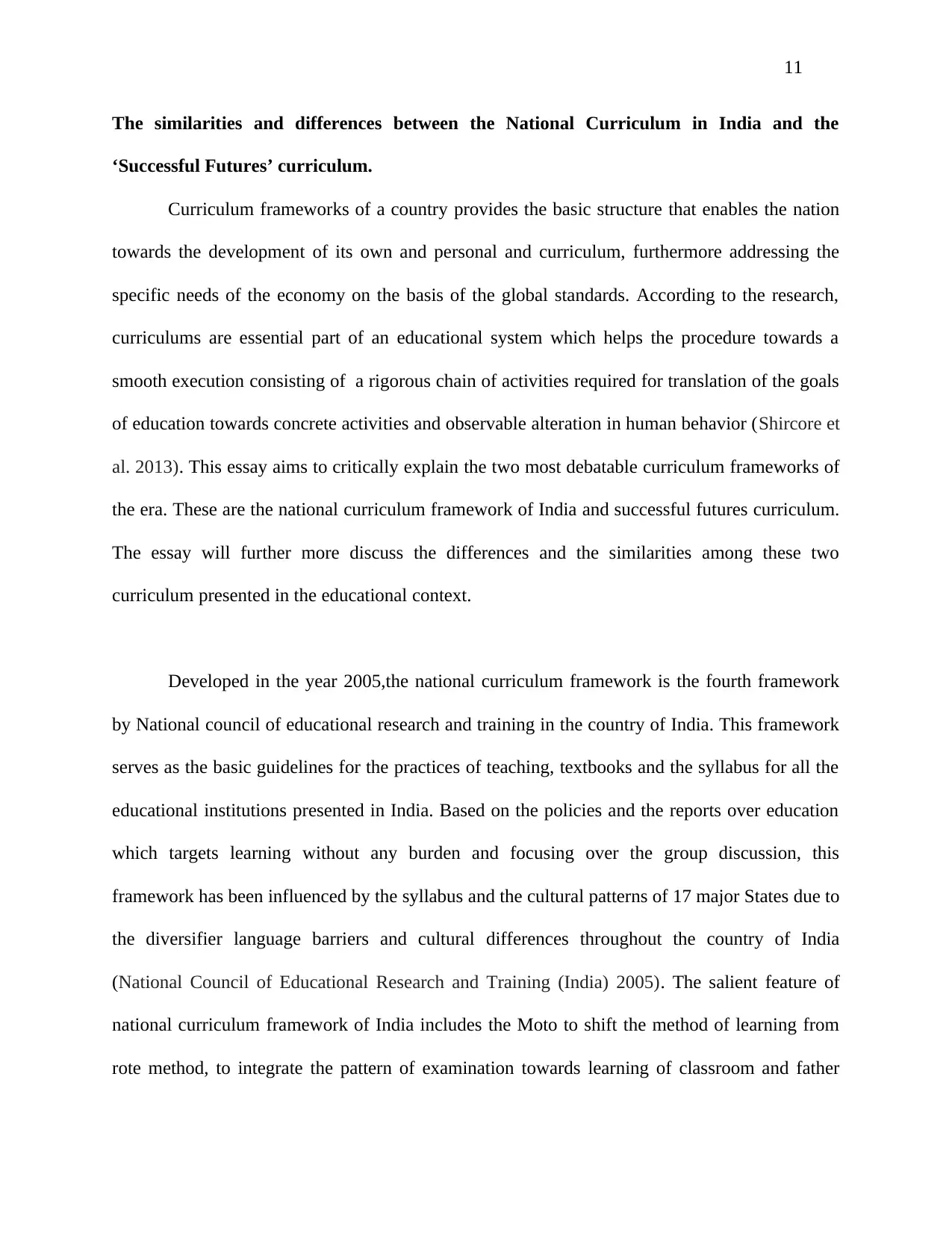
11
The similarities and differences between the National Curriculum in India and the
‘Successful Futures’ curriculum.
Curriculum frameworks of a country provides the basic structure that enables the nation
towards the development of its own and personal and curriculum, furthermore addressing the
specific needs of the economy on the basis of the global standards. According to the research,
curriculums are essential part of an educational system which helps the procedure towards a
smooth execution consisting of a rigorous chain of activities required for translation of the goals
of education towards concrete activities and observable alteration in human behavior (Shircore et
al. 2013). This essay aims to critically explain the two most debatable curriculum frameworks of
the era. These are the national curriculum framework of India and successful futures curriculum.
The essay will further more discuss the differences and the similarities among these two
curriculum presented in the educational context.
Developed in the year 2005,the national curriculum framework is the fourth framework
by National council of educational research and training in the country of India. This framework
serves as the basic guidelines for the practices of teaching, textbooks and the syllabus for all the
educational institutions presented in India. Based on the policies and the reports over education
which targets learning without any burden and focusing over the group discussion, this
framework has been influenced by the syllabus and the cultural patterns of 17 major States due to
the diversifier language barriers and cultural differences throughout the country of India
(National Council of Educational Research and Training (India) 2005). The salient feature of
national curriculum framework of India includes the Moto to shift the method of learning from
rote method, to integrate the pattern of examination towards learning of classroom and father
The similarities and differences between the National Curriculum in India and the
‘Successful Futures’ curriculum.
Curriculum frameworks of a country provides the basic structure that enables the nation
towards the development of its own and personal and curriculum, furthermore addressing the
specific needs of the economy on the basis of the global standards. According to the research,
curriculums are essential part of an educational system which helps the procedure towards a
smooth execution consisting of a rigorous chain of activities required for translation of the goals
of education towards concrete activities and observable alteration in human behavior (Shircore et
al. 2013). This essay aims to critically explain the two most debatable curriculum frameworks of
the era. These are the national curriculum framework of India and successful futures curriculum.
The essay will further more discuss the differences and the similarities among these two
curriculum presented in the educational context.
Developed in the year 2005,the national curriculum framework is the fourth framework
by National council of educational research and training in the country of India. This framework
serves as the basic guidelines for the practices of teaching, textbooks and the syllabus for all the
educational institutions presented in India. Based on the policies and the reports over education
which targets learning without any burden and focusing over the group discussion, this
framework has been influenced by the syllabus and the cultural patterns of 17 major States due to
the diversifier language barriers and cultural differences throughout the country of India
(National Council of Educational Research and Training (India) 2005). The salient feature of
national curriculum framework of India includes the Moto to shift the method of learning from
rote method, to integrate the pattern of examination towards learning of classroom and father
⊘ This is a preview!⊘
Do you want full access?
Subscribe today to unlock all pages.

Trusted by 1+ million students worldwide
1 out of 16
Related Documents
Your All-in-One AI-Powered Toolkit for Academic Success.
+13062052269
info@desklib.com
Available 24*7 on WhatsApp / Email
![[object Object]](/_next/static/media/star-bottom.7253800d.svg)
Unlock your academic potential
Copyright © 2020–2025 A2Z Services. All Rights Reserved. Developed and managed by ZUCOL.





